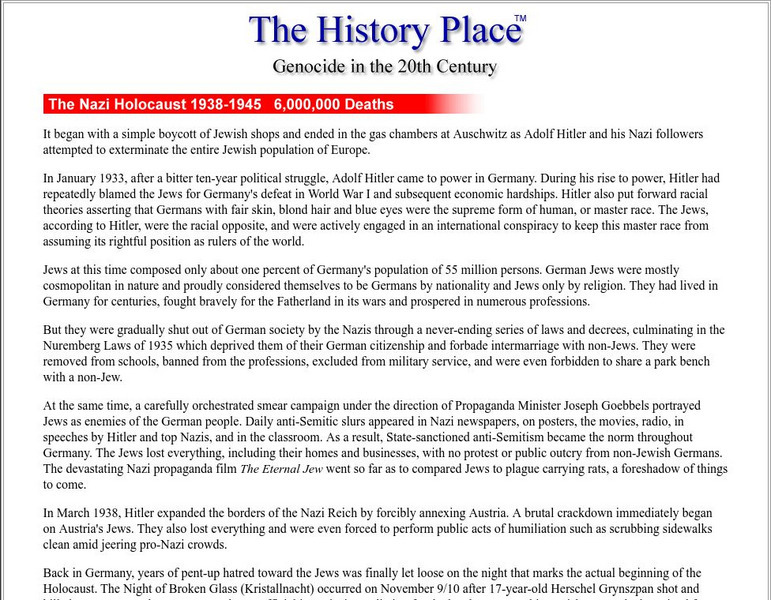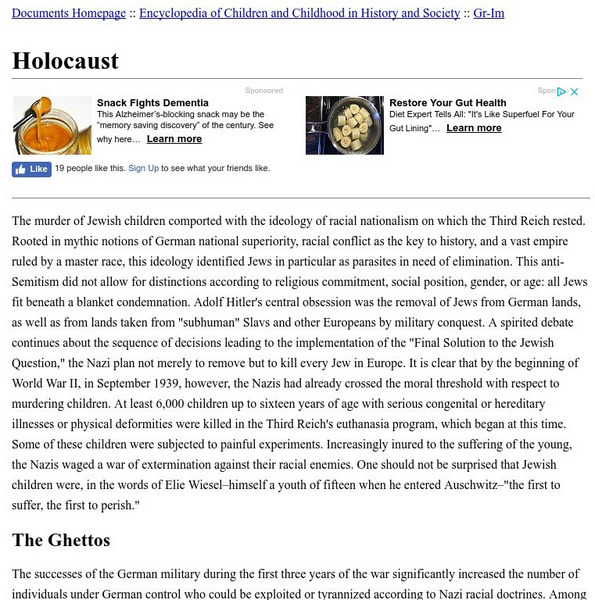US Holocaust Memorial Museum
U.s. Holocaust Memorial Museum: Lublin/majdanek Concentration Camp
An account of the role the Majdanek concentration camp in Poland played both in providing labor for the Nazi war effort and in the "final solution" the Nazis planned.
US Holocaust Memorial Museum
U.s. Holocaust Memorial Museum: Concentration Camps: 1939 1942
Article summarizing the development and use of numerous concentration camps by the Nazis in the early years of World War II. The camps were used to provide forced labor, retain political prisoners, and any populations the Nazis wanted to...
US Holocaust Memorial Museum
U.s. Holocaust Memorial Museum: Concentration Camps, 1942 1945
Article details the Nazi need for forced labor and the solution they found in the concentration camps they established. It also mentions the use of prisoners in medical experiments.
US Holocaust Memorial Museum
U.s. Holocaust Memorial Museum: Concentration Camps, 1933 1939
Article detailing the development and use of concentration camps in pre-World War II Germany to detain political enemies, subversives, and so-called "social deviants."
US Holocaust Memorial Museum
Ushmm: Holocaust Encyclopedia: Liberation of Nazi Camps
Article outlining the roles of the various Allied armies, including the Russian, American, and British forces, in liberating the Nazi concentration camps in the late months of World War II.
American-Israeli Cooperative Enterprise
Jewish Virtual Library: Drancy Concentration Camp
Describes what the Drancy concentration/death camp in France was like during WWII.
American-Israeli Cooperative Enterprise
Jewish Virtual Library: Nazi Concentration Camps
This page has links to detailed pages on all of the concentration, labor, and extermination camps used by Hitler and the Nazis in WWII. These camps were used to round up and exterminate the millions of Jews and other minorities in Europe...
The History Place
The History Place: The Nazi Holocaust 1938 1945
Article depicting the Nazi Holocaust from the beginning in 1938 with a simple boycott to the end in 1945 with the liberation of the death camps.
US Holocaust Memorial Museum
U.s. Holocaust Memorial Museum: Nazi Camps
Extensive site created by the US Holocaust Memorial Museum to explain the people involved with the Nazi concentration/death camps. Learn about who was targeted, and how those who led the camps were ultimately punished. Site provides...
US Holocaust Memorial Museum
U.s. Holocaust Memorial Museum: Nazi Medical Experiments
A description of the use of concentration camp prisoners for medical experimentation by the Nazis during World War II.
US Holocaust Memorial Museum
U.s. Holocaust Memorial Museum: Sobibor
A description of the Nazi concentration camp at Sobibor in Poland, and of the prisoner uprising there.
American-Israeli Cooperative Enterprise
Jewish Virtual Library: Reinhard Heydrich
A detailed biography of "the Hangman" of World War II Nazi Germany.
US Holocaust Memorial Museum
U.s. Holocaust Memorial Museum: Westerbork
Article about the camp at Westerbork, the Netherlands, originally created by the Dutch to intern Jewish refugees, but later used as a transit camp by the Nazis, a holding place for Jews being sent to other concentration camps.
Internet FAQ Archive
Faq Archives: Encyclopedia of Children and Childhood in History and Society: Holocaust
Looks at the devastating impact of the Holocaust and concentration camps on Jewish families and children. Some material is quite graphic and difficult to read, as it describes the cruelty the Nazis inflicted on Jewish people.
US Holocaust Memorial Museum
U.s. Holocaust Memorial Museum: Jasenovac
Article about the concentration camps established by the Nazis in the area around Jasenovac in Croatia, and their use in eliminating political and religious opponents, as well as Jews shipped in from other places in Eastern Europe.
US Holocaust Memorial Museum
U.s. Holocaust Memorial Museum: Belzec
A description of the Belzec concentration camp in Poland, run by the Nazis between 1941 and 1943.
US Holocaust Memorial Museum
U.s. Holocaust Memorial Museum: Auschwitz Through the Lens of the Ss
A collection of photographs taken by an SS officer, Karl Hocker, who was stationed at the Auschwitz concentration camp in 1944. Use the links on the page to go to related articles and the photographs
US Holocaust Memorial Museum
U.s. Holocaust Memorial Museum: Dachau
Article about the Dachau concentration camp which housed almost 200,000 prisoners, both political and ethnic, in the period between 1933, when the Nazis took power in Germany, and mid-1945 when the Allies liberated the camps.
US Holocaust Memorial Museum
U.s. Holocaust Memorial Museum: Ohrdruf
Article about the concentration camp at Ohrdruf, a subcamp of Buchenwald. Ohrdruf was the first camp to be liberated by the Allied forces, in April 1945.
US Holocaust Memorial Museum
U.s. Holocaust Memorial Museum: Killing Centers: An Overview
A disturbing accounting of the Nazis' Final Solution, the extermination camps where millions of Jews and others were gassed during the Holocaust. Included are hyperlinks to photographs, personal stories, and film footage.
American-Israeli Cooperative Enterprise
Jewish Virtual Library: Death Marches
This Jewish Virtual Library site describes the death marches that Nazi-held prisoners like the Jews, the Russians, and other minorities were forced to take from one concentration camp to another. On these marches the prisoners died...
Other
Simon Wiesenthal Center: About Simon Wiesenthal
Information about Nazi hunter Simon Wiesenthal, prepared for the web site of the foundation that carries his name and whose ongoing work is one of bringing Nazi perpetrators to justice.
US Holocaust Memorial Museum
U.s. Holocaust Memorial Museum: Warsaw
An article about the Nazi treatment of the Polish capital, Warsaw, after the invasion of Poland. Information about the creation and destruction of the Jewish ghetto, and the later destruction of most of the city and its inhabitants.
US Holocaust Memorial Museum
Ushmm: Holocaust Encyclopedia: Persecution of Homosexuals in the Third Reich
Entry describes the Nazi persecution of gays. Includes information on the criminal code Paragraph 175 and the pink triangle symbol used to mark gay men in concentration camps.


